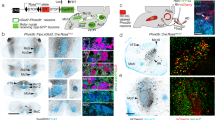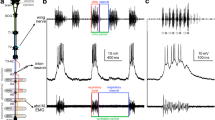Summary
The integration of feeding-related sensory inputs by cerebral to buccal interneurons (CBs) was examined in preparations consisting of the isolated CNS attached to the sensory receptors on the lips. Responses of CBs to tactile stimulation of the lips were dependent upon what portion of the lip was stimulated. Generally responses of phasic CBs to touch of the outer surface of the lip were inhibitory while responses to touch of the inside of the mouth were excitatory. The tonic CBs, CBST and CBEPSP, were strongly excited by touch of the inner or outer lip. Responses of CBs to chemostimuli applied to the lip paralleled those of intact slugs. Chemostimuli such as fructose or food-plant extracts which stimulate feeding in intact slugs excited CBs while chemostimuli aversive to intact slugs, quinidine sulfate and citric acid, inhibited phasic CBs. Some CBs appear to be monosynaptically connected to taste-sensory afférents in the CG while others are more indirectly connected. Synaptic inputs to CBs which are phase-locked to the feeding rhythm and characteristic of phasic CBs, were found to be dependent upon an intact ipsilateral cerebral buccal connective and are the result of phasic activity of neurons in the buccal ganglia, not the cerebral ganglia. Strong electric shock of the foot of intact slugs causes an immediate withdrawal response and inhibition of feeding behavior and responsiveness to food lasting several minutes. Brief electric shock of foot tissue in vitro inhibits CBs and fictive feeding and blocks or reduces the ability of attractive taste stimuli to excite CBs and initiate fictive feeding for up to 10 min. This offers the possibility of studying a neuronal correlate of behavioral sensitization in this in vitro preparation.
Similar content being viewed by others
Abbreviations
- BG :
-
buccal ganglion
- CB :
-
cerebral-buccal interneuron
- CBC :
-
cerebral-buccal connectives
- CG :
-
cerebral ganglion
- CPG :
-
central pattern generator
- FMP :
-
feeding motor program
References
Barnes WJP, Gladden MH (1985) Central feedback loops and some implications for motor control. In: Barnes WJP, Gladden MH (eds) Feedback and motor control in invertebrates and vertebrates. Croom Helm Ltd., Dover N.H.
Benjamin PR, Rose RM (1979) Central generation of bursting in the feeding system of the snail Lymnaea stagnalis. J Exp Biol 80:93–118
Broyles JL, Sokolove PG (1978) Pedal wave recovery following transection of pedal nerves in the slug Limax maximus. J Exp Zool 206:371–380
Chiel HL, Weiss KR, Kupfermann J (1986) An identified histaminergic neuron modulates feeding motor circuitry in Aplysia. J Neurosci 6(8):2427–2450
Cohan CS, Mpitsos GJ (1983) The generation of rhythmic activity in a distributed motor system. J Exp Biol 102:25–42
Culligan N, Gelperin A (1983) One-trial associative learning by an isolated molluscan CNS: Use of different chemoreceptors for training and testing. Brain Res 266:319–327
Davis WJ (1985) Central feedback loops and some implications for motor control. In: Barnes WJP, Gladden MH (eds) Feedback and motor control in invertebrates and vertebrates Chapt 2. Croom Helm Ltd., Dover, New Hamsphire, pp 13–33
Davis WJ, Seigler MVS, Mpitsos GJ (1973) Distributed neuronal oscillators and efference copy in the feeding system of Pleurobranchaea. J Neurophysiol 36:258–274
Davis WJ, Gillette R, Kovac M, Croll RP, Matera EM (1983) Organization of synaptic inputs to paracerebral interneurons of Pleurobranchaea californica III. Modifications induced by experience. J Neurophysiol 47(6):1557–1572
Davis WJ, Croll RP, Kovac MP, Matera EM (1984) Brain oscillato(s) underlying rhythmic cerebral and buccal motor output in the mollusc, Pleurobranchaea. J Exp Biol 110:1–15
Delcomyn F (1980) Neural basis of rhythmic behavior in animals. Science 210:492–498
Delaney K, Chang JJ (1987) Suppresion of fictive feeding by foot shock in Limax maximus: neural correlates in withdrawal and feeding systems. Biol Bull 173:437
Delaney K, Gelperin A (1984) Rapid food-aversion learning with shock as UCS in Limax maximus. Soc Neurosci Abstr 10:691
Delaney K, Gelperin A (1990a) Cerebral interneurons controlling fictive feeding in Limax maximus. I. Anatomy and criteria for re-identification. J Comp Physiol A 166:297–310
Delaney K, Gelperin A (1990b) Cerebral interneurons controlling fictive feeding in Limax maximus. II. Initiation and modulation of fictive feeding. J Comp Physiol A 166:311–326
Egan ME, Gelperin A (1981) Olfactory inputs to a bursting serotonergic interneuron in a terrestrial mollusc. J Mollusc Stud 47:80–88
Gelperin A, Culligan N (1984) In vitro expression of in vivo learning by an isolated molluscan CNS. Brain Res 304:207–213
Gelperin A, Chang JJ, Reingold SC (1978) Feeding motor program in Limax I. Neuromuscular correlates and control by chemosensory input. J Neurobiol 9:285–300
Getting PA (1983a) Mechanisms of pattern generation underlying swimming in Tritonia. II. Network reconstruction. J Neurophysiol 49(4):1017–1035
Getting PA (1983b) Mechanisms of pattern generation underlying swimming in Tritonia. III. Intrinsic and synaptic mechanisms for delayed excitation. J Neurophysiol 49(4):1036–1050
Gillette R, Davis WJ (1977) The role of the metacerebral giant neuron in the feeding behavior of Pleurobranchaea. J Comp Physiol 116:129–154
Gillette R, Kovac MP, Davis WJ (1978) Command neurons in Pleurobranchaea receive synaptic feedback from the motor network they excite. Science 199:798–801
Kemenes G, Elliott CJH, Benjamin PR (1986) Chemical and tactile inputs to the Lymnaea feeding system: Effects on behaviour and neural circuitry. J Exp Biol 122:113–137
Kovac MP, Davis WJ, Matera E, Gillette R (1982) Functional and structural correlates of cell size in neurons of Pleurobranchaea californica. J Neurophysiol 47(5):909–927
Kovac MP, Davis WJ, Matera E, Croll RP (1983a) Organization of synaptic inputs to paracerebral feeding command interneurons of Pleurobranchaea californica. I. Excitatory inputs. J Neurophysiol 49(6):1517–1538
Kovac MP, Davis WJ, Matera E, Croll RP (1983b) Organization of paracerebral feeding command interneurons of Pleurobranchaea californica II. Inhibitory inputs. J Neurophysiol 49(6):1539–1556
London JA, Gillette R (1984) Rhythmic and bilaterally coordinated motor activity in the isolated brain of Pleurobranchaea. J Exp Biol 108:471–475
Lukowiak K (1986) A blood-borne factor in Aplysia may mediate the suppressive behavioral state associated with food satiation. Soc Neurosci Abstr 12:38
McClellan AD (1982) Re-examination of presumed feeding motor activity in the isolated nervous system of Pleurobranchaea. J Exp Biol 98:213–228
Murray MJ, Lewis ER (1974) Sensory control of prey capture in Navanax inermis, Veliger 17:156–158
Pearson KG (1985) Are there central pattern generators for walking and flight in insects? In: Barnes WJP, Gladden MH (eds) Feedback and motor control in invertebrates and vertebrates, Chapt 20. Croom Helm, Dover New Hampshire, pp 307–315
Phifer CB, Prior DJ (1985) Body hydration and haemolymph osmolality affect feeding and its neural correlate in the terrestrial gastropod, Limax maximus. J Exp Biol 118:405–426
Preston RJ, Lee RM (1973) Feeding behavior in Aplysia californica: role of chemical and tactile stimuli. J Comp Physiol Psychol 82:368–381
Prior DJ, Gelperin A (1974) Behavioral and physiological studies on locomotion in the giant garden slug Limax maximus. Malacological Rev 7:50–51
Prior DJ, Gelperin A (1977) Autoactive molluscan neuron: Reflex function and synaptic modulation during feeding in the terrestrial slug Limax maximus. J Comp Physiol 114:217–232
Reingold SC, Gelperin A (1980) Feeding motor program in Limax. II. Modulation by sensory inputs in intact animals and isolated central nervous system. J Exp Biol 85:1–19
Rosen SC, Weiss KR, Cohen JL, Kupfermann I (1982) Interganglionic cerebral-buccal mechanoafferents of Aplysia: Receptive fields and synaptic connections to different classes of neurons involved in feeding behavior. J Neurophysiol 48:271–288
Sahley CL, Rudy JW, Gelperin A (1981) An analysis of associative learning in a terrestrial mollusc: higher-order conditioning, blocking and a transient US pre-exposure effect. J Comp Physiol 144:1–8
Sahley CL, Hardison P, Hsuan A, Gelperin A (1982) Appetitively reinforced odor-conditioning modulates feeding in Limax maximus. Soc Neurosci Abstr 8:825
Senseman DM (1978) Short-term control of food intake by the terrestrial slug Ariolimax. J Comp Physiol 124:37–48
Weeks JC (1981) Neuronal basis of leech swimming: Separation of swim initiation, pattern generation, and intersegmental coordination by selective lesions. J Neurophysiol 45:698–723
Author information
Authors and Affiliations
Rights and permissions
About this article
Cite this article
Delaney, K., Gelperin, A. Cerebral interneurons controlling fictive feeding in Limax maximus . J Comp Physiol A 166, 327–343 (1990). https://doi.org/10.1007/BF00204806
Accepted:
Issue Date:
DOI: https://doi.org/10.1007/BF00204806




